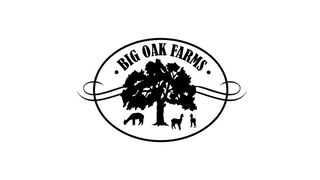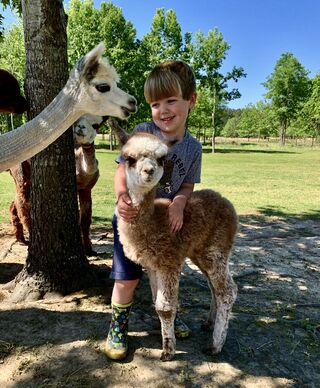Alpaca Q&A
Wednesday, March 30, 2022
What is an alpaca?
Alpacas are members of the camelid family. Most people are familiar with the ones with humps; the dromedary of Northern Africa, the Middle East, and Southern Asia, and the Bactrian camel of China and Tibet. However, there are four other camelids (without humps) that are indigenous to South America: two of them, llamas and alpacas, have been domesticated for thousands of years; whereas the other two varieties, guanacos and vicunas, continue to roam in wild herds today.
The alpaca comes in two breed-types: Huacaya (pronounced wuh KAI ya) and suri (SUR ee). Huacayas, the more common type, account for about 90% of all alpacas. Huacaya fiber is a bright, crimpy, soft fiber, that is well suited to knitted, crocheted, and woven applications. Suri fiber, on the other hand, is naturally silky, smooth, cool to the touch, with high luster. Suri has a natural drape which makes it perfect for flowing scarves, shawls, and gowns.
How long do alpacas live?
Alpacas can live between 15- 20 years with the longest documented life span of 28 years.
Are Alpacas different from llamas?
People often confuse alpacas with llamas but they are very different animals. Llamas are about twice the size of an alpaca, weighing between 250 to 450 pounds. The average alpaca weighs between 120 and 200 pounds on average. Llamas are primarily used for packing or for guarding herds of sheep or alpacas. Alpacas are primarily raised for their soft and luxurious fleece.
Are alpacas an "exotic species," or are they considered simply "livestock?"
Alpacas have been raised as domestic livestock for thousands of years and since the end-product of alpacas is their fleece, like sheep, they are classified as livestock by both the United States and Canadian federal governments.
Do alpacas spit?
All members of the camel family use spitting as a means of negative communication. They do get possessive around food, and thus may express annoyance by spitting at other alpacas that they perceive are encroaching on "their" food. Also, they often spit at one another during squabbles within the herd (usually involving two or more males). From time to time alpacas do spit at people on purpose, but it is more common that humans get caught in the cross-fire between alpacas, so it’s best to study their behavior and learn to avoid the most vulnerable situations.
Do alpacas make noise?
Alpacas are very quiet, docile animals that generally make a minimal amount of sound. They generally make only a pleasant humming sound as a means of communication or to express concern or stress. Occasionally you will hear a shrill sound, called an "alarm call," which usually means they are frightened or angry with another alpaca. Male alpacas also "serenade" females during breeding with a guttural, throaty sound called "orgling."
Are alpacas dangerous?
No?—?they are safe and pleasant to be around. They do not bite or butt and do not have sharp teeth, horns, hooves, or claws as other types of livestock do. They move gracefully and adroitly about the field and are therefore unlikely to run into or over anyone, even small children. Occasionally, an alpaca will reflexively kick with its hind legs, especially if touched from the rear, but the soft padded feet usually do little more than just "get your attention."
Is it OK to have just one alpaca?
As a general rule, the answer is no. Alpacas have very strong herding instincts and need the companionship of other alpacas to thrive. Gender-appropriate (or neutered) llamas sometimes will successfully bond with an alpaca. Otherwise, it is best to provide each alpaca with a companion alpaca of the same gender.
Are alpacas easy to care for?
They are a small and relatively easy livestock to maintain. They stand about 36' high at the withers (where the neck and spine come together); weigh between 100 to 200 pounds; and establish easy-to-manage, communal dung piles. The alpacas need basic shelter and protection from heat and foul weather, just like other types of livestock, and they also require certain vaccinations and anti-parasitic medicines. Their fleece is sheared once a year to keep them cool in summer. Additionally, their toenails need to be trimmed on an as-needed basis to ensure proper foot alignment and comfort. Interestingly, alpacas do not have hooves?—?instead, they have two toes, with hard toenails on top and a soft pad on the bottom of their feet, which minimizes their effect on pastures and makes them an "environmentally friendly" animal.
How much space does it take to raise an alpaca?
Because these animals are environmentally friendly and require so little pasture and food, you can usually raise from two to eight alpacas on an acre of land, depending on terrain, rain/snowfall amounts, availability of pasture, access to fresh water, etc. They can also be raised on a dry lot and fed grass hay. Consult with your local USDA office for specific local recommendations.
Are alpacas clean animals?
Yes, they are much cleaner than most livestock. Alpacas have minimal aroma and tend to attract less flies in the summertime than other forms of livestock. Furthermore, alpacas often defecate in communal dung piles. There may be three or four of these areas in a pasture, spread throughout about 10% to 20% of the pasture. This makes for easy clean-up, reduced opportunity for parasites, and better overall hygiene in the herd.
What do I need by way of shelter and fencing?
While the shelter requirements vary depending on weather and predators. As a general rule, alpacas need at least a three-sided, open shelter, where they can escape from the heat of the sun in summer and from icy wind and snow in winter. If predators (dogs, coyotes, bears, etc.) are present in your neighborhood, then a minimum of five-foot-high, 2' x 4' no-climb fencing is strongly recommended. Traditional horse fencing with 6' x 6' openings is not recommended, as curious alpacas have been harmed by putting their heads or legs through the openings.
What do alpacas eat?
Alpacas mainly eat grass or hay, and not much—approximately two pounds per 125 pounds of body weight per day. The general rule of thumb is 1.5% of the animal’s body weight daily in hay or fresh pasture. A single, 60 pound bale of hay can generally feed a group of about 20 alpacas for one day. Grass hay is recommended, while alfalfa should be fed sparingly, due to its overly rich protein content. Alpacas are pseudo-ruminants, with a single stomach divided into three compartments. They produce rumen and chew cud, thus they are able to process this modest amount of food very efficiently. Many alpacas (especially pregnant and lactating females) will benefit from nutritional and mineral supplements, depending on local conditions. There are several manufactured alpaca and llama feeds and mineral mixes readily available; consult with your local veterinarian to ensure you are feeding the appropriate diet for your area. Alpacas also require access to plenty of fresh water to drink.
Alpacas have two sets of teeth for processing food. They have molars in the back of the jaw for chewing cud. But in the front, the alpaca has teeth only on the bottom and a hard gum (known as a dental pad) on the top for crushing grain, grass, or hay. Unlike goats and sheep that have long tongues which they sometimes use to rip plants out of the ground, alpacas have short tongues and nibble only the tops of grasses and other plants, resulting in less disturbance of the vegetation. However, alpacas are also browsers and will often eat shrubs or the leaves from trees if given the opportunity. This requires monitoring to ensure they do not consume harmful products.
Can alpacas thrive in locations with very hot or very cold climates?
Generally, yes. Alpacas are amazingly resilient animals and have adapted successfully to the extremes of both very hot and very cold climates. In hot, humid climates, alpaca owners need to take extra precautions to make sure that the alpacas do not suffer from heat stress. These include: shearing fleeces early in the year, providing fans and ventilation in the barn, offering cool fresh water for drinking, and hosing off their bellies (where heat is dissipated) on very hot days.
Does the birthing require human assistance?
In most cases, cria are born without intervention, and usually during daylight hours. A cria normally weighs between 15 and 19 pounds and is usually standing and nursing within 90 minutes of birth. The cria continues to nurse for about six months until it is weaned.
Are alpacas easy to train?
Alpacas are very smart animals and are fairly easy to train. It is best to start training them when they are young so that they will accept a halter and learn to follow on a lead. Many owners also enjoy training them to walk through obstacles; some even compete with their alpacas at shows where they walk over, through, and around objects and also jump over small hurdles. Also, it is helpful to train alpacas to ride in a trailer or van if they ever need to be transported to a show or another farm. Alpacas are easy to transport, as they normally cush (lay down with their legs folded under them) when traveling.
So what do you DO with these animals?
Alpacas are raised for their soft and luxurious fleece (sometimes called fiber). Each shearing produces roughly five to ten pounds of fleece per animal, per year. This fleece, often compared to cashmere, can be turned into a wide array of products from yarn and apparel to tapestries and blankets. The fleece itself is recognized globally for its fineness, softness, light-weight, durability, excellent thermal qualities, and luster.
In addition to selling the fleece and the animals, many alpaca owners operate a retail store selling alpaca end-products—either on or off their farms. Products are sold directly to consumers at their store or over the Internet. Many also sell alpaca products through craft fairs, farmers markets, and retail sites. Sales of these end-products can provide considerable supplemental income to alpaca owners.
What about the fleece?
Let’s start by comparing alpaca fleece with wool from most breeds of sheep. In general, alpaca fleece is stronger, lighter, warmer, and more resilient. Finer grades of alpaca fleece (known commercially as "Baby Alpaca") are believed to be hypo-allergenic, meaning it does not irritate your skin as sheep’s wool sometimes does. Unlike sheep’s wool, alpaca fleece contains no lanolin and is therefore ready to spin after only nominal cleaning. Prized for its unique silky feel and superb "handle," alpaca fleece is highly sought-after by both cottage-industry artists (hand spinners, knitters, weavers, etc.) as well as the commercial fashion industry.
Alpaca fleece has a great variety of natural colors, making it very much in vogue: 22 colors (white; beige; and shades of fawn, brown, black, and grey) with many other subtle shades and hues. White, light fawn, and light grey can be readily dyed, thus offering a rainbow of colors for the fiber artist. Alpaca fleece can also be combined with other fine fibers such as merino wool, cashmere, mohair, silk, and angora to attain incredibly interesting blends.
Do I need to purchase a registered alpaca?
Simple answer—yes. Anytime you are investing money, you need to take all the necessary steps to help assure that your investment maintains its value and registered alpacas do just that.
Alpaca Owners Association, Inc. (AOA) is the largest alpaca pedigree registry in the world. While AOA provides services to alpaca owners all over the world, they primarily provide pedigree registration and member services to the United States and Canada. AOA is one of the few livestock registries of any kind that requires that every animal be DNA tested back to its parents before being registered. As a result, AOA registered alpacas are highly desired.
Are there organized exhibitions and competitions for alpacas?
Yes, there are many alpaca shows (both show ring and fleece judging competitions) held throughout North America where owners can showcase their animals and fleeces. Alpaca Owners Association, Inc. (AOA) certifies regional shows and fairs all over the United States. AOA administers the show rules, trains the judges, and offers other assistance to these certified shows. AOA also hosts the National Alpaca Show & Auction and National Fleece Show each year.
South American Alpacas
Alpacas are kept in herds that graze on the level heights of the Andes of Ecuador, southern Peru, northern Bolivia, and northern Chile. Alpacas are considerably smaller than llamas, and unlike llamas, alpacas are not used as beasts of burden but are valued only for their fiber. Alpaca fiber is used for making knitted and woven items, much as sheep's wool is. These items include blankets, sweaters, hats, gloves, scarves, a wide variety of textiles and ponchos in South America, and sweaters, socks, coats and bedding in other parts of the world. The fiber comes in more than 52 natural colors as classified in Peru, 12 as classified in Australia and 16 as classified in the United States. Alpacas and llamas differ in that alpacas have straight ears and llamas have banana-shaped ears. Aside from these differences, llamas are on average 1–2 feet taller and proportionally bigger than alpacas.
Alpacas have been domesticated for thousands of years. In fact, the Moche people of Northern Peru often used Alpaca images in their art. There are no wild alpacas. The closest living species are the wild Vicuña, also native to South America. Along with Camels and Llamas, the Alpaca are classified as camelids. The Alpaca is larger than the Vicuña but smaller than the other camelid species.
Of the various camelid species, the Alpaca and Vicuña are the most valuable fiber-bearing animals: the alpaca because of the quality and quantity of its fiber, and the vicuña because of the softness, fineness and quality of its coat. Alpacas are too small to be used as pack animals. Instead, they were bred exclusively for their fiber and meat.
Alpacas are social herd animals that live in family groups consisting of a territorial alpha male, females and their young. They are gentle, elegant, inquisitive, intelligent and observant. As they are a prey animal, they are cautious and nervous if they feel threatened. They like having their own space and may not like an unfamiliar alpaca or human getting close, especially from behind. They warn the herd about intruders by making sharp, noisy inhalations that sound like a high pitch burro bray. The herd may attack smaller predators with their front feet, and can spit and kick. Due to the soft pads on their feet, the impact of a kick is not as dangerous as that of a hoofed animal, yet it still can give quite a bruise, and the pointed nails can inflict cuts.





